Gone But Not Forgotten: We Take A Tour Around Some Of The UK&I's Lost Par 3s
Enjoy our round-up of some of the UK&I's lost par 3s on courses that are otherwise still very much alive and well, and find out when and why they fell by the wayside


Fancy playing the cracking little par 3 in our lead image here at Doonbeg in County Clare? Probably, but then again, maybe not given how hard a target it looks to find even from only 111 yards. Either way, sadly you can’t, for this particular par 3 no longer exists, even though when Greg Norman’s dramatic modern links opened in 2003 it was generally touted as the signature hole.

The view from behind Doonbeg's old par-3 14th with Doughmore Bay to the left
Its setting above the vast sandy beach of Doughmore Bay and its vulnerability to the elements made it hard to maintain, and when a certain Mr Trump purchased the property in 2014, it became one of the casualties of Norman’s handiwork as Martin Hawtree was brought in to change things up and, in some cases, shore things up.
I had the pleasure of playing it several times and had pretty much resorted to attempting some kind of long pitch-and-run with an 8- or 9-iron in a desperate attempt to find the putting surface anywhere, for there was simply no good miss. And missing was all too easy despite its meagre yardage.
When you think about how many courses have closed over the years, a huge number of cracking par 3s must have disappeared, but this feature is not about such losses. Rather, it’s about active courses that have retired par 3s for various reasons, often out of necessity, sometimes out of desire. Some I have played and enjoyed over the years, others I never got to experience, but there has always been a fascination for me about how they used to play and why they were cast aside, especially when some misty-eyed member points it out and tells me what a great hole it was.
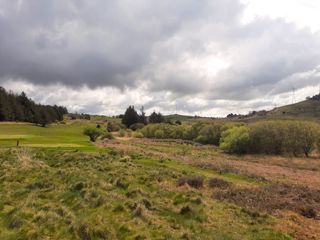
Looking down the long-lost par 3 at Maesteg in Wales - the old green site is in the centre of this photo
Maesteg in the Welsh valleys had one such hole, a short downhiller that switched back to the left of the par-5 11th, a lovely little par 3 lost when things were reconfigured at the far end of the course apparently. Barnard Castle in County Durham had a good-looking par 3 on the back nine that is actually still there but no longer part of the routing. I was told it was sometimes brought back when required, but it looked a fine hole with its slightly raised green and it was hard to fathom why it had been retired – again, probably for practical reasons related to reconfiguration.
Two courses I know well have lost a couple of par 3s over the past two decades. Goodwood’s Downs course in Sussex, a James Braid creation I first played while at college in Chichester, lost the fine par-3 3rd that played down into a valley you now drop into earlier from a different direction on a new 2nd hole created by Howard Swan in 2004 as part of a project that also sought to make crossing the busy road up to Goodwood racecourse a less risky affair. The tees are still there, but there’s little evidence of the former short par-3 18th, another ‘casualty’ of the project, which played to a green in front of the Kennels clubhouse.
At Prince’s in Kent, fairly recent work by Martin Ebert has led to the Shore nine’s old 8th being retired along with the former 3rd on the Himalayas nine, although the latter’s green lives on via the new par-5 2nd, a merging of the former 2nd and 3rd holes. In both instances, they’ve been replaced by beautifully adorned short par 3s that play directly towards the sea.
Get the Golf Monthly Newsletter
Subscribe to the Golf Monthly newsletter to stay up to date with all the latest tour news, equipment news, reviews, head-to-heads and buyer’s guides from our team of experienced experts.

The green on the now-retired former par-3 8th on the Shore nine at Prince's
That’s four holes on two courses very familiar to me that I played many times yet will never do so again. But next is one that I’d heard about but never got to play – the old 170-yard par-3 12th, ‘Moor Top’, at Moortown in Yorkshire, which fell victim to encroachment, as secretary/manager, Peter Rishworth, explains: “In the late 1960s and early 1970s, two of our then neighbouring courses sold land for housing development. Moor Allerton, with whom Moortown shared around a quarter of its boundaries, sold its entire site and relocated three miles north to Wike; and Sand Moor also relocated four of its holes, two of which bordered our 17th and 18th. Both sales quickly created major boundary issues that resulted in necessary course changes to protect against potential injunctions that may have forced closure of sections of the course.
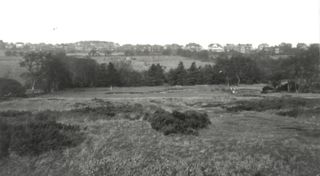
The lost par-3 12th - 'Moor Top' - at Moortown in Yorkshire
“The committee’s main aim was to maintain as much of the course as possible, but some changes were unavoidable. That old par-3 12th had to be closed and the 13th and 14th holes redesigned into the current 14th. The 17th also had to be shortened from a par 4 to a par 3. To replace the two lost holes, the club developed the wooded area to the left of the 5th to create today’s 6th and 7th holes. These were opened in 1989.”
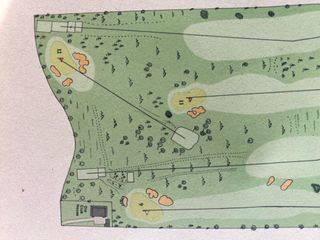
The old par-3 12th at Moortown (top left) was well-bunkered
At close neighbour, Headingley, I’d seen photos of an extraordinary-looking 2nd hole, which turned right and played steeply up via some lavish bunkering to a green beside today’s 13th green. You then played a 170-yard downhill par 3 from close to today’s 14th tee to an attractively bunkered green, which you can still make out on your left as you play the excellent par-5 14th. When the 2nd hole was straightened to avoid the steep ascent in 1954, that 3rd hole effectively became collateral damage.

The old par-3 3rd at Headingley was lost when the layout was altered in the 1950s
Staying in Yorkshire, another that had caught my eye was the old par-3 12th at Ganton because of a black and white photo of Jimmy Demaret playing to its green in the 1949 Ryder Cup. You still get to pretty much hit this same shot, which is now the drive on today’s par-4 12th, although bigger hitters may try to fire it over the right-hand trees as this 398-yarder turns sharp right where that old 12th green once stood.
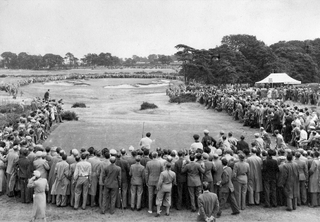
Jimmy Demaret playing from the tee of the old par-3 12th at Ganton in the 1949 Ryder Cup
The par-3 hole was in Tom Dunn's original course plans as the 11th, as today’s 11th had not yet been constructed. In the early days, the tee shot was played over a row of tall trees, which were thankfully later cut down as tastes in the kind of challenge a golf hole - and particularly a par 3 - should pose evolved.
Plans overseen by CK Cotton to change it to a dogleg par 4 were already in the pipeline before the 1949 Ryder Cup. The committee wanted to tighten up the layout for the GB vs USA contest and various new tees were put into play, But ultimately, they ran out of time for the desired changes to the 12th and its conversion to a par 4 was delayed until after the event. It played as a 212-yard par 3 during the Ryder Cup but was ten yards shorter for general play. The 12th began its new life as a par 4 in 1952, with today’s green previously the Ganton Village bowling green.
Many more such tales no doubt exist throughout the UK, sufficient to fill a book I suspect, albeit one that would require extensive research. But finally, for now, it’s back to my home county of Sussex and some recent discoveries about a couple of lost par 3s at Cowdray Park, which course architect, William Swan, told me about after my recent visit to see the fruits of a major renovation project he had masterminded.
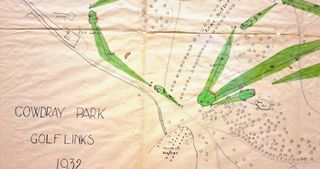
Part of a plan from 1932 showing the lost original par-3 17th at Cowdray Park in the centre
The routing between 16 and 18 had always confused me a little as you have to walk quite a long way from the 16th green to the 17th tee and then pretty much all the way back down 17 to the 18th tee. The reason is simple – the old par-3 17th used to play across a dip known as Lime Bottom, taking you more naturally from the 16th green to the 18th hole. It was only 102 yards and played right beside the main road to a narrow green with bunkers front, left and rear.
“The old 17th came out of play when the A272 became too busy to play alongside,” Swan tells me. “Unfortunately, there are no signs of it on the ground any more. It was replaced with the current Tom Simpson-designed 17th in the 1930s. I imagine the old hole would have been charming played across the valley. I toyed with the idea of trying to play to the current 17th green across Lime Bottom, but it was nixed fairly quickly due to the Capability Brown landscape heritage.”
When I played with Swan before the renovation, he also told me about a former routing in which the second half of today’s par-4 15th was the original 163-yard, par-3 8th - as with the old 3rd on the Himalayas at Prince’s, a hole not so much lost as repurposed. “The old 8th tee is very much still visible, even if there are a couple of trees growing on it,” Swan tells me. “I believe it was removed when Hawtree and Son built the current 5th and 6th holes in the 1970s. I have discussed with Jon Smith, the course manager, whether it could be brought back just for fun use on occasion. Even though the green must have been rebuilt, it would still make a fun par 3 with the new bunkering.”
In the 1,500 or so words afforded me here, I’ve only scratched the surface of the UK’s lost par 3 catalogue. Indeed, just as I was completing this article, Swan sent me information about another lost par 3, this time with a wonderfully bunkered Harry Colt green at Foxton Hall, Alnmouth. “Colt’s 171-yard par-3 3rd was lost when they established RAF Boulmer in 1940, with two other seaside holes lost as well,” his email read. “Annoyingly from a golfer’s perspective, RAF Boulmer was only a decoy airfield. I think there was some flight activity at some point and the station still operates in some sort of security capacity, just not with aircraft on site.”
You may well know of others, but the evolution of our courses, and reasons behind it, continues to fascinate me so I will continually be on the look-out for tell-tale signs and titbits of information about more par 3s of yesteryear on my travels.

Jeremy Ellwood has worked in the golf industry since 1993 and for Golf Monthly since 2002 when he started out as equipment editor. He is now a freelance journalist writing mainly for Golf Monthly. He is an expert on the Rules of Golf having qualified through an R&A course to become a golf referee. He is a senior panelist for Golf Monthly's Top 100 UK & Ireland Course Rankings and has played all of the Top 100 plus 91 of the Next 100, making him well-qualified when it comes to assessing and comparing our premier golf courses. He has now played 1,000 golf courses worldwide in 35 countries, from the humblest of nine-holers in the Scottish Highlands to the very grandest of international golf resorts. He reached the 1,000 mark on his 60th birthday in October 2023 on Vale do Lobo's Ocean course. Put him on a links course anywhere and he will be blissfully content.
Jezz can be contacted via Twitter - @JezzEllwoodGolf
Jeremy is currently playing...
Driver: Ping G425 LST 10.5˚ (draw setting), Mitsubishi Tensei AV Orange 55 S shaft
3 wood: Srixon ZX, EvenFlow Riptide 6.0 S 50g shaft
Hybrid: Ping G425 17˚, Mitsubishi Tensei CK Pro Orange 80 S shaft
Irons 3- to 8-iron: Ping i525, True Temper Dynamic Gold 105 R300 shafts
Irons 9-iron and PW: Honma TWorld TW747Vx, Nippon NS Pro regular shaft
Wedges: Ping Glide 4.0 50˚ and 54˚, 12˚ bounce, True Temper Dynamic Gold 105 R300 shafts
Putter: Kramski HPP 325
Ball: Any premium ball I can find in a charity shop or similar (or out on the course!)
-
 Joe Highsmith Wins Maiden PGA Tour Title At Cognizant Classic After Making Cut On The Number
Joe Highsmith Wins Maiden PGA Tour Title At Cognizant Classic After Making Cut On The NumberJoe Highsmith took advantage of a Jake Knapp disaster at the 11th to claim his maiden PGA Tour title
By Mike Hall Last updated
-
 Who Is Jake Knapp's Girlfriend? Meet Makena White
Who Is Jake Knapp's Girlfriend? Meet Makena WhiteFind out more about Makena White - the Canadian woman Knapp has been in a relationship with since August 2023...
By Jonny Leighfield Published